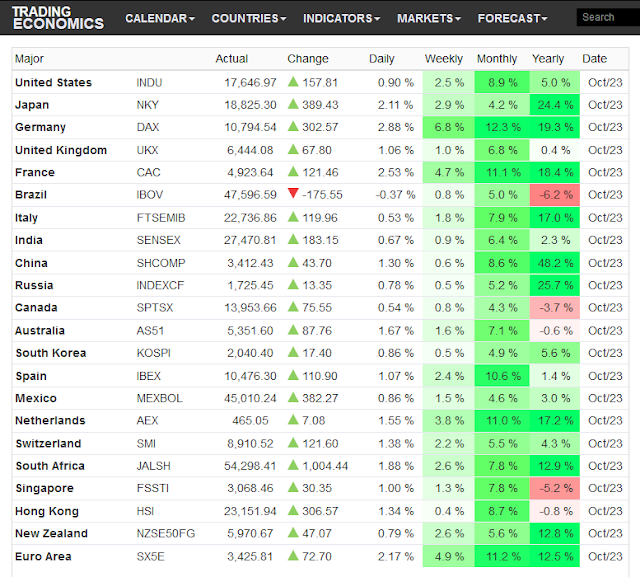Global stock market returns for 2015 (yearly gains) via Trading Economics.
China's Shanghai Composite index leads (+48%) the major indices on a yearly basis, despite the sharp plunge from June's highs above 5,000. Brazil's Bovespa (-6%) lags, the worst performer of the major indices.
You can find the full global list, covering Asia, Africa, Europe, and the Americas, at Trading Economics (link above). Here's a quick rundown of the best performing global markets for 2015.
1. China's Shanghai Composite up 48% for the year. The SSEC and new A-Share market ETF, ASHR had a huge run from late 2014 into mid-2015.
2. Russia Stock Market MICEX is up 26% on a 1-year basis. This ruble-denominated index is moving in on its all-time highs, while the dollar-denominated RTS index sits near 5-year lows.
3. Iceland's SE ICEX is up 51% over the past year. The Icelandic market has been steadily gaining ground the last 5 years after falling off a cliff in the 2007-2008 financial crisis.
4. Jamaica's stock market Jamaica SE is up 73% for the year. Click through to the index page and select the 1-year chart to see its recent breakout move.
5. Ireland's ISEQ is up 39% on the year and is trading at levels not seen since early 2008.
Among the worst performing markets in 2015: Ukraine's PFTS -38%, Saudi Arabia TASI -27%, and Kenya's NSE20 -24%. Venezuela's IBVC index, up 295% in local currency terms, is also underwater if the country's real world annual inflation rate of 808% is accounted for.
We'll check back in at year end to see the final tally for 2015. Thanks for reading, and see you next week!
You can follow our real-time updates on Twitter and StockTwits. Subscribe to Finance Trends via RSS or get new updates by email (see "Follow by Email" on our main page).
China's Shanghai Composite index leads (+48%) the major indices on a yearly basis, despite the sharp plunge from June's highs above 5,000. Brazil's Bovespa (-6%) lags, the worst performer of the major indices.
You can find the full global list, covering Asia, Africa, Europe, and the Americas, at Trading Economics (link above). Here's a quick rundown of the best performing global markets for 2015.
1. China's Shanghai Composite up 48% for the year. The SSEC and new A-Share market ETF, ASHR had a huge run from late 2014 into mid-2015.
2. Russia Stock Market MICEX is up 26% on a 1-year basis. This ruble-denominated index is moving in on its all-time highs, while the dollar-denominated RTS index sits near 5-year lows.
3. Iceland's SE ICEX is up 51% over the past year. The Icelandic market has been steadily gaining ground the last 5 years after falling off a cliff in the 2007-2008 financial crisis.
4. Jamaica's stock market Jamaica SE is up 73% for the year. Click through to the index page and select the 1-year chart to see its recent breakout move.
5. Ireland's ISEQ is up 39% on the year and is trading at levels not seen since early 2008.
Among the worst performing markets in 2015: Ukraine's PFTS -38%, Saudi Arabia TASI -27%, and Kenya's NSE20 -24%. Venezuela's IBVC index, up 295% in local currency terms, is also underwater if the country's real world annual inflation rate of 808% is accounted for.
We'll check back in at year end to see the final tally for 2015. Thanks for reading, and see you next week!
You can follow our real-time updates on Twitter and StockTwits. Subscribe to Finance Trends via RSS or get new updates by email (see "Follow by Email" on our main page).
